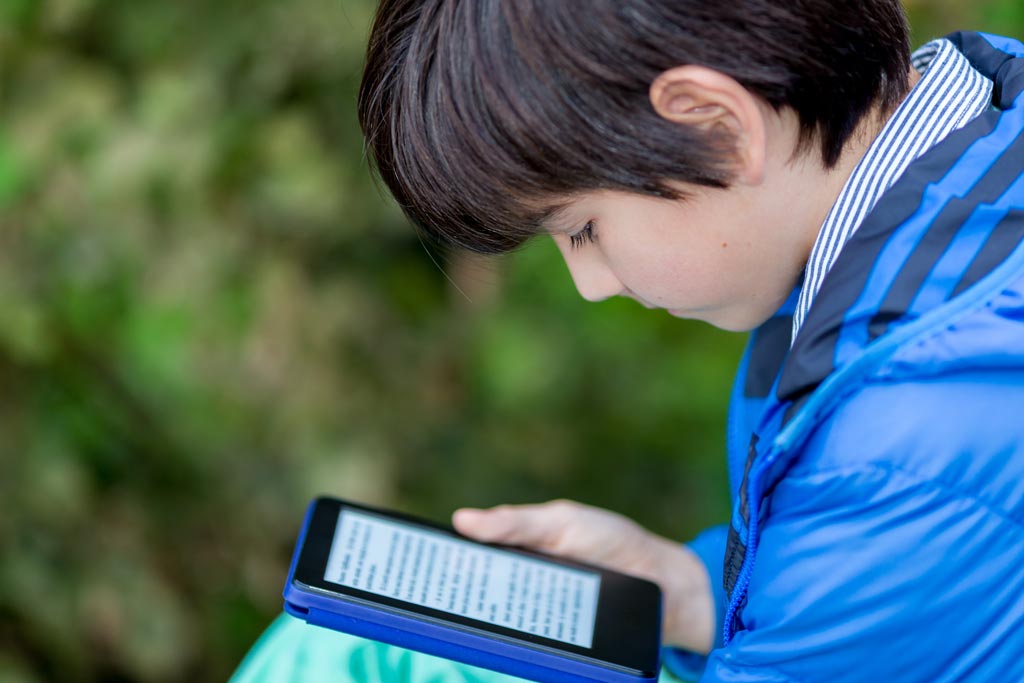
For most parents and educators, developing a child’s reading skills and helping them discover the life-changing world of books is a mission close to their hearts. Instilling a love of reading in a reluctant or struggling reader is a challenging task, with the distraction of electronic devices being one more hurdle to overcome.
So, for children who are struggling readers, encouraging them to read on (yet) another electronic device may seem—at first glance—ill-advised or even self-defeating.
Why an E-Reader?
As someone who has been an avid reader all my life and an e-reader devotee for some 14 years,* it still surprises me that many people disregard e-readers without ever having used one. Books can be read on a smartphone or tablet, they argue, so why add another device to the mix?
In fact, e-readers, such as the Kindle Paperwhite, offer several distinct advantages for children who are hesitant to pick up a traditional book. As a person passionate about children’s reading development, I want to explain why I’m an advocate of electronic readers for children, especially for struggling or reluctant readers.
A dedicated e-reader is not an all-purpose device like a smartphone or tablet, with unfettered access to the online world and unlimited uses. The singular focus of an e-reader is what makes it unique—and also what enables it to help ease the challenges faced by struggling readers.
I’ve condensed the advantages of e-readers to these 8 key qualities:
- Purpose-built reading device
- No LCD or LED screen glare
- Customization and accessibility features
- Reading privacy and discretion
- Built-in dictionary
- Vocabulary builder
- More varied content and free book samples
- Portability and convenience.
* Note: As my experience has only been on the Kindle, I will focus my discussion on its features, some of which may not be available in other e-readers. My current e-reader is the Kindle Paperwhite (10th generation, 2018 model).
1. Purpose-Built Reading Device
Reading on a Kindle reader is a very different experience than reading on a tablet (such as an iPad or Amazon Fire), a smartphone, or a computer. In contrast to reading an e-book on a tablet or computer, the Kindle is an e-book device. It has been custom-purpose-built so that it emulates reading a book, and elevates the reading experience.
How?
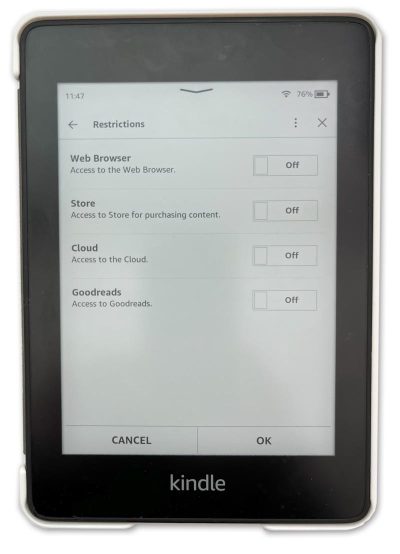
Firstly, with password-protected parental controls enabled, there’s no access to social media or games, or the internet (access to which is quite limited, regardless). Web access for browsing and purchasing books, Goodreads, or Wikipedia can be selectively blocked using the device’s parental control settings.
For that reason, picking up a Kindle can feel as relaxing to pick up as a physical book.
What’s more, it removes the need to monitor if your child has diverted to a game, social media, or other activity contained on the same device. Remember: it’s a single-focus, single-purpose device.
2. No LCD or LED Screen Glare
The Kindle e-reader is not a backlit device. It uses front lighting LEDs and e-ink, which is a type of display technology that imitates the look of ink on a page. Unlike the screens in smart phones and tablets that use backlit LED or LCD lighting, e-ink has a paper-like appearance and is very matte.
It doesn’t glow and it doesn’t produce the same stimulation in the brain as luminous screens. (Apologies, the shadow on the Dark Mode display is mine!)
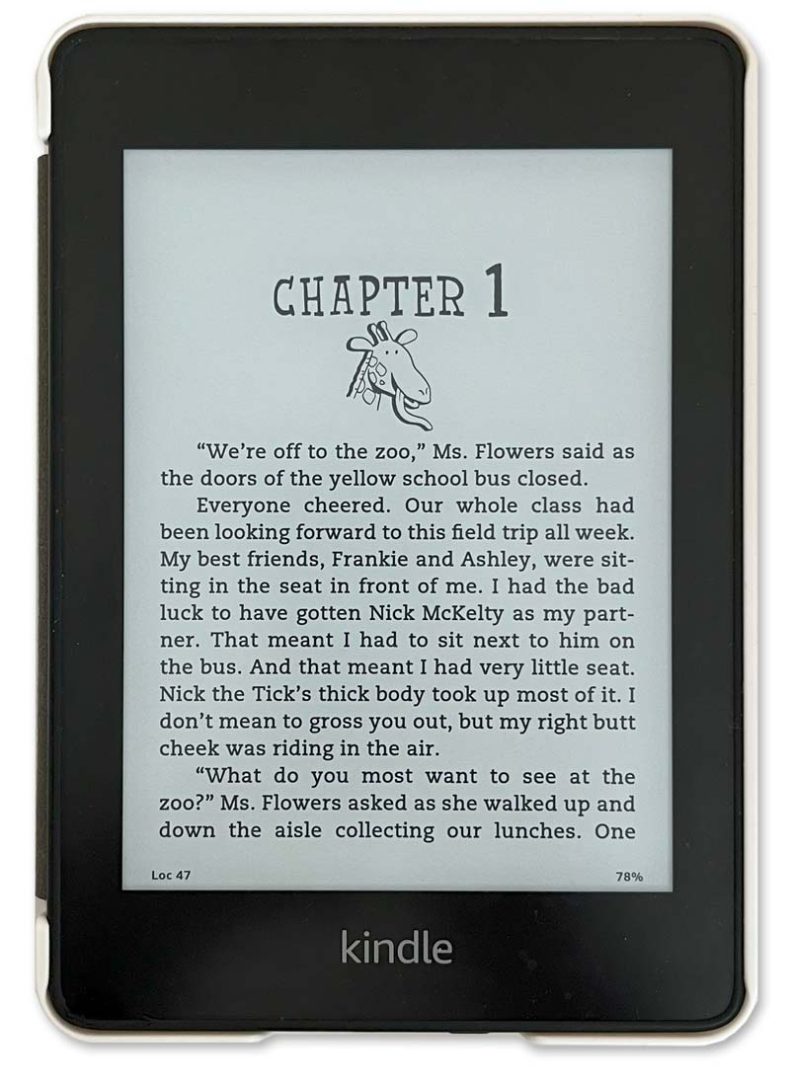
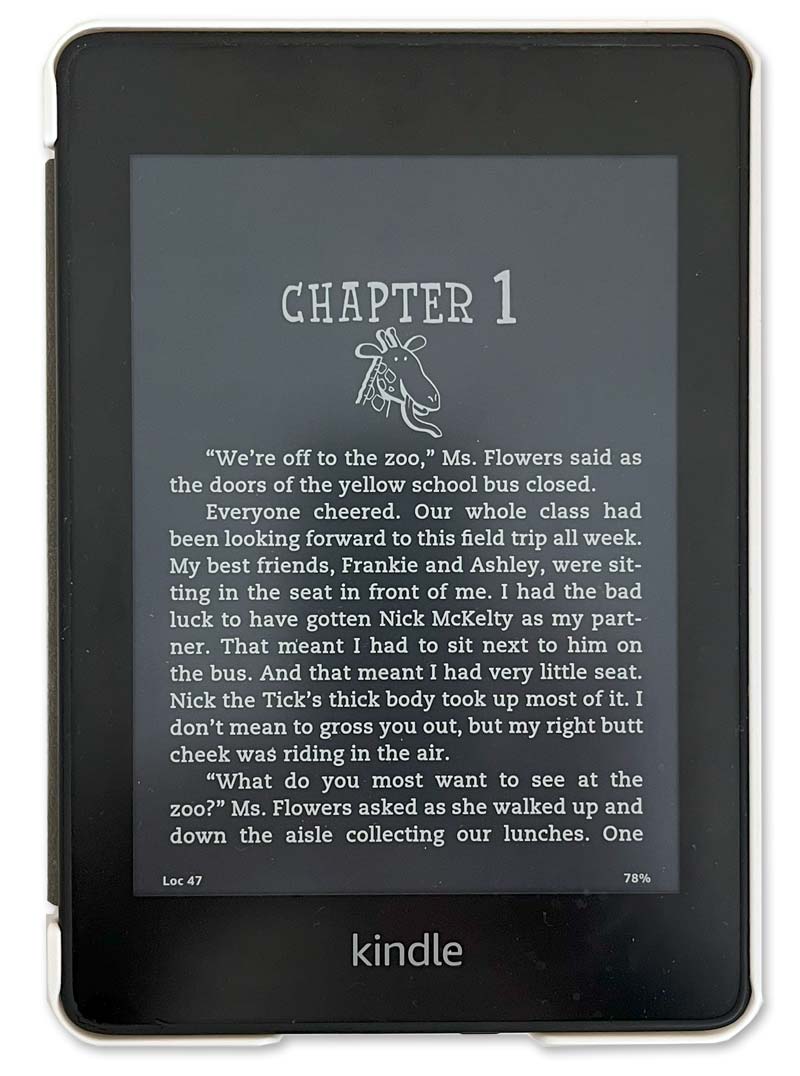
It also has incremental ranges of brightness (settings 1-24) for both regular and Dark Mode (inverse screen), which makes it great for a variety of light situations, from bright sunlight to a dimly lit room.
Consequently, it causes much less eye strain and doesn’t reduce the eye’s blink rate. In my experience, if using the lower brightness settings, eye strain is almost non-existent, even when reading for an extended period. The e-ink display uses negligible power so that the battery lasts up to a month without charging.**
This means less hassle and downtime for charging and more time for the important task of reading!
Truly, to appreciate the restfulness of e-ink, you have to see it. Go take a look!
** Note: Time between required charging depends on many factors including hours of use and brightness of display, however, I’ve found the biggest single power draw is when wi-fi is on. Since you only need connectivity to look for or download a book (downloading typically takes less than one minute), keeping the Kindle otherwise in airplane mode will ensure weeks of use without recharging.
3. Customization and Accessibility Features
Struggling readers often find that printed books can be intimidating due to their length and the amount of text on each page. Even as an avid reader, whenever I pick an old classic off my bookshelf and see the small font crammed in tight lines on the page, I find it discouraging!
Kindle e-readers allow for easy customization of text elements:
- font size
- font/typeface style
- line spacing
- line justification
- margins.
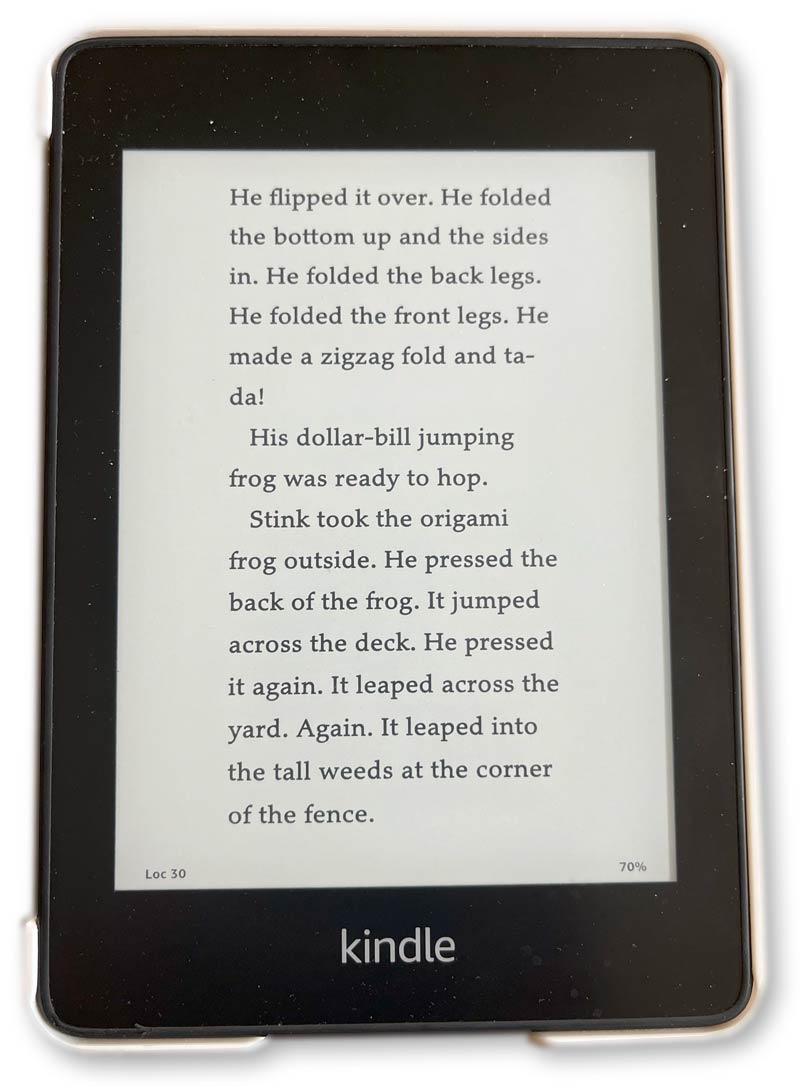
Kindle e-reader page with margins enlarged and line spacing increased so that fewer words appear on the page, creating a less intimidating reading environment for reluctant readers. Font type and size can also be adjusted.
Book: “Stink and the Scary Spider” by Megan McDonald, suitable for children ages 6 and up (The Stink series, book #12)
Control over how the page is laid out enables children to read without feeling overwhelmed by the number of words on the page. Whether your child is just starting to read or has more advanced skills, you can adjust the layout to suit their needs.
This customization can make the reading experience less daunting, encouraging them to start—and continue—reading.
For reluctant readers, particularly those with physical reading challenges such as dyslexia or vision impairment, the ability to adjust the text display and screen brightness is extremely helpful. Choosing a clear, modern, font and limiting the number of words on a page can ease the reader’s anxiety enormously.
One of the standard fonts available on Kindle is OpenDyslexic. This is a free font designed to mitigate some of the common reading errors caused by dyslexia.
If the language in the book is not a child’s first language, there is also a word translation feature available.
4. Reading Privacy and Discretion
Understandably, children can be self-conscious about their reading abilities or the level of book they’re reading, especially if they struggle with comprehension or vocabulary. Perhaps they’re reading at a level somewhat below their peers, or they may feel their reading genre will draw unwanted attention.
With an e-reader, your child can read with some discretion. It provides a private reading environment to explore books without fear of judgment from classmates. This sense of privacy can boost children’s confidence and encourage them to read more frequently.
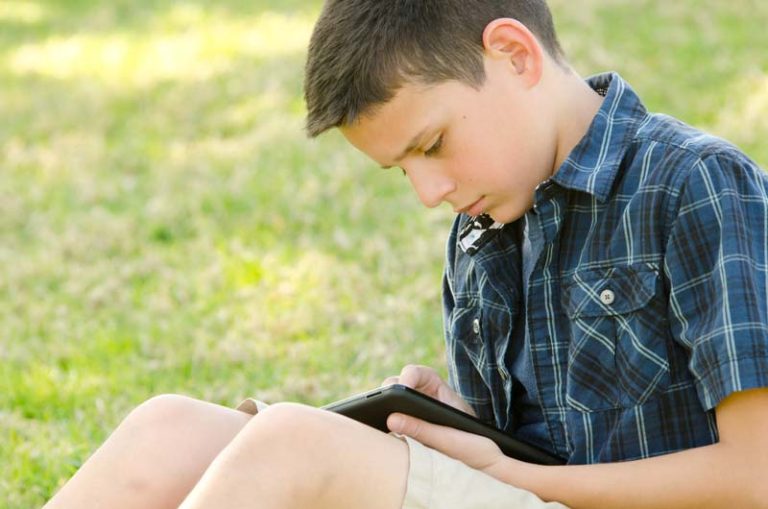
5. Built-in Dictionary
For reluctant readers, encountering unfamiliar words can be a major roadblock to comprehension and enjoyment. Kindles feature built-in dictionaries (in various languages, if English is not the child’s first language), making it easy for children to look up word meanings instantly.
Just tap on a word to instantly access definitions without leaving the book. So quick and easy! I use this regularly, although I’d almost never bother to hunt up the meaning in a physical dictionary or online. It might be an unfamiliar word; or sometimes, I just like to enhance my formal understanding of a word or see its various definitions.
This dictionary feature helps promote vocabulary development and expand comprehension, both of which boost confidence and are necessary skills for tackling more complex books.
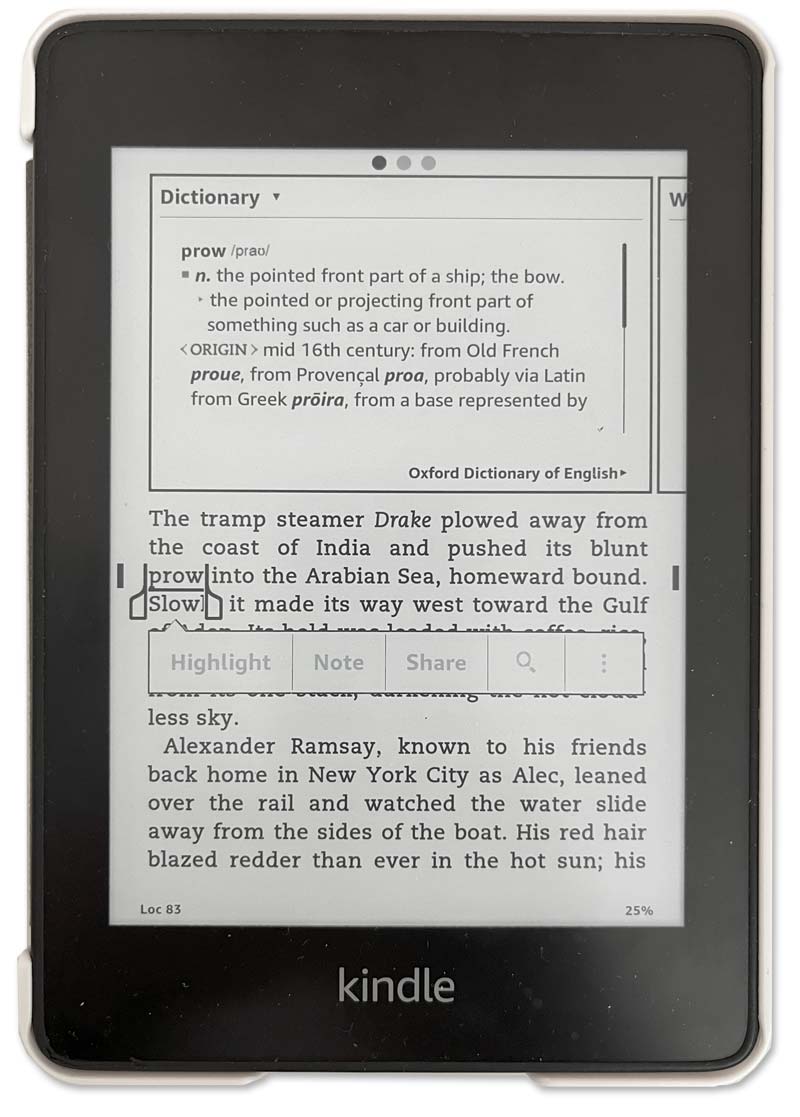
Kindle E-Reader dictionary, accessible immediately, simply by tapping on a word. Here, the definition of the word “prow” is displayed.
Book: The Black Stallion by Walter Farley, suitable for children ages 8 and up (The Black Stallion series, book #1)
6. Vocabulary Builder
One of my favorite features is the integrated Vocabulary Builder! I discovered it (only by accident) when it was added in 2016. It’s an amazingly useful tool, regardless of age, but especially for the developing or struggling reader.
What is the Vocabulary Builder?
The Vocabulary Builder is a personalized list of all the words you’ve tapped on to get a definition while reading. Rather than being associated with a given book, it’s a single list accumulated across all the books you’ve read on the Kindle.
Whenever you look up a word in the dictionary (by holding a finger on it), the word is automatically added to your separate Vocabulary Builder list. The words remain in your list until you delete them.
Here are some of the reading benefits of the Vocabulary Builder:
- You can personally review words and their meanings at a later stage
- Have someone test you on spelling and definitions of unfamiliar words
- Parents and teachers can easily see which words need practice and reinforcement
- You can make up a family quiz game with them (okay, we’re a bit nerdy in our family!)
The Vocabulary Builder is a an easy and practical way to review new and problem words.
7. More Varied Content & Free Book Samples
I must admit there is a Kindle feature I love even more—way more—than the Vocabulary Builder: I love the instant access to a vast array of books. Books are simultaneously a necessity and a luxury. For me, instant access to books is an affordable luxury that never loses its luster. This luxury is made even more affordable by the attractive price of e-books, which are often considerably cheaper than printed books.
To help foster reading in children, the facility to readily access a wide variety of content via the Kindle is key. Reluctant and struggling readers can find books that align with their hobbies, passions, or favorite genres, making it more likely they will discover books that genuinely engage them.
Parents can easily purchase and download books tailored to their child’s age and reading level, ensuring that there’s always something new and interesting to read.
Selecting books can be a daunting task for reluctant readers, or any child who’s unsure of their preferences. Kindle allows you to start a book with a free book sample before committing to a purchase. Additionally, recommendations based on their reading history can help kids discover new books that align with their interests.
What’s more, books are available instantly so kids can get reading a book right away. When they’re in the right frame of mind to read—especially if they want to seamlessly follow on to the next book in a series—the ease of downloading an e-book allows the reading flow to continue.
8. Portability and Convenience
Like we adults, children have a lot of stuff to carry these days! Whether it’s to school and back, house-to-house, or activity to appointment, physical books add weight and volume. Often, when there’s an unanticipated change of family plans or a late-running appointment, a child’s printed book isn’t with them.
Kindles are lightweight and portable, making it easy for reluctant readers to take their e-books—in fact, their entire library—with them wherever they go. The Kindle is so easy to carry, mine is almost always with me! Rather than get impatient at an appointment delay, I now consider “waiting time” as simply a quiet reading oasis in an otherwise busy day.
The Kindle’s convenience helps ensure that kids can read anytime, anywhere, whether it’s in the car, on vacation, waiting at appointments, or before bedtime. What’s more, the Kindle is the same weight and is easy to hold, regardless of the size and dimension of the printed book. (I thank the Kindle for getting me through tomes like ‘War and Peace’!)

Most importantly, this accessibility allows kids to stay in the flow of a story and become more engaged once they start a book. Long stretches between reading sessions or reading only at the end of the day when children are tired can deter struggling readers.
Kindle Devotee
Clearly, I am an unashamed Kindle devotee, but I am sincere in my enthusiasm about the advantages e-readers offer struggling or reluctant readers. And have no doubt, they are also a wonderful device for children of all reading abilities, as many avid readers will happily attest to!
So, disregard your preconceived notions. Consider that, rather than being another “connected” and distracting device, an e-reader uses technology to enhance the learning process and support the reluctant reader at their own pace and comfort. By reducing the intimidation factor, providing accessibility, portability, and catering to individual reading preferences, the Kindle can help children overcome their hesitations, develop their language skills, and become lifelong readers.
As an Amazon Associate, I earn from qualifying purchases. The opinions in this blog are entirely my own and unsolicited.
Note: This article relates only to the features and usefulness of a physical e-reader device, specifically, the Kindle. It is not a recommendation or endorsement of the Amazon Kids+ subscription service, which includes access to apps, games, videos, etc. Personally, I favor device simplicity and no ongoing subscription commitments. You can always purchase a fun, age-appropriate cover to make it a “kids” e-reader.
